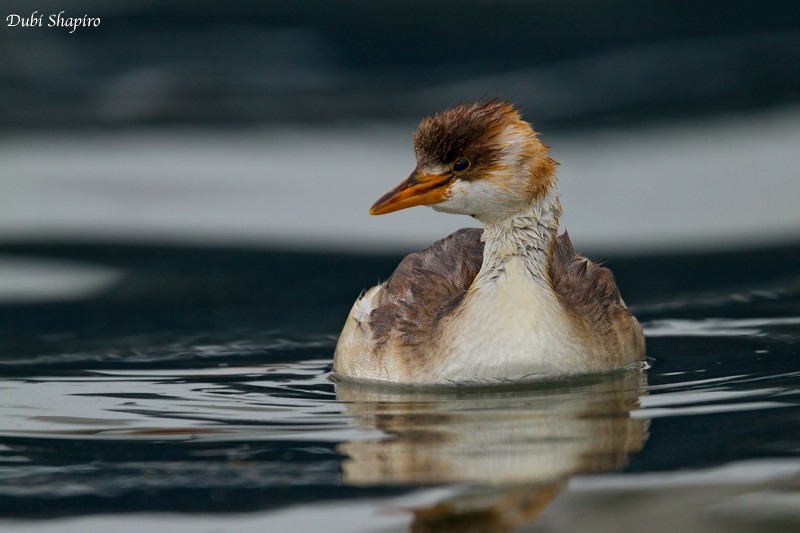Titicaca Grebe
A species of White-tufted and Titicaca Grebes, Also known as Short-winged Grebe Scientific name : Rollandia microptera Genus : White-tufted and Titicaca Grebes
Titicaca Grebe, A species of White-tufted and Titicaca Grebes
Also known as:
Short-winged Grebe
Botanical name: Rollandia microptera
Genus: White-tufted and Titicaca Grebes
Content
Description General Info
 Photo By Dubi Shapiro
Photo By Dubi Shapiro Description
This is a mid-sized grebe, varying from 28–45 cm in overall length. It weighs up to 600 g. Its coloration is unmistakable. The only grebe species it somewhat resembles is the unrelated red-necked grebe which is not found in South America. The only congener, the white-tufted grebe, does not look very similar. The color pattern of the Titicaca grebe is altogether similar to that of the red-necked grebe, but it has a darker belly, and a white (not light grey) throat patch that runs down the neck nearly to the breast. Due to the short wings, the rufous flanks can usually be seen. The ornamental plumes on the head are a vestigial version of those of the white-tufted grebe, but dark. Iris and the lower bill are yellow. Juveniles and non-breeding adults are duller, lack the ornamental plumes, and in the case of the former have rufous stripes on the sides of the head and more white on the neck, so that the rufous breast does not show in swimming birds. It is entirely flightless, but will use wing-assisted running over considerable distances. It is an excellent diver, reaching a burst speed of 3.5 km/h (2 knots). 
Size
45 cm
Nest Placement
Floating
Feeding Habits
Titicaca Grebe primarily consume Orestias pupfish, accounting for 95% of their diet. They select prey under 15 cm, avoiding larger, commercially significant silversides. Titicaca Grebe's feeding strategy revolves around their size preference, emphasizing the importance of small fish in their diet.
Habitat
The habitat of titicaca Grebe consists primarily of expansive open lakes rich in reedbeds or floating vegetation within the high Andean region. These birds are particularly drawn to zones that support patchy aquatic vegetation such as totora reeds, ensuring they have ample open water for their requirements.
Dite type
Piscivorous
General Info
Feeding Habits
Bird food type
Distribution Area
The Titicaca flightless grebe occurs in a habitat mosaic in relatively shallow waters (up to about 10 m/35 ft deep). The reed belt is found in water of up to 4 m (13 ft) deep and constitutes the breeding habitat. It is made up mainly of Totora (Schoenoplectus californicus ssp. tatora). Other plants are the underwater Myriophyllum elatinoides and Hydrocharitaceae water weeds, and the floating duckweeds and Azolla. Potamogeton constitute the dominant underwater vegetation in the deeper parts, down to 14 m (some 45 ft). In a study by O'Donnel and Fjeldsa they concluded that Grebes are strongly impacted and sensitive to environmental change. 
Species Status
It is classified by the IUCN as Endangered, with a population of less than 750 adults (BirdLife International 2006). Censuses in the latter part of the 20th century revealed that the population had declined from several thousand coincident with the introduction of monofilament line gill nets in the 1990s. It was confirmed (Martinez et al. 2006) that the mortality of grebes drowning in these nets is considerable, killing potentially thousands of individuals each year in 2003. Obviously, the 2001 survey which detected very low numbers was flawed for some reason and the species must be more common simply to sustain such losses. In 2003, the number of individuals was estimated to be over 2,500, with more than 750 mature birds, possibly as many as 1,500. This still is a marked decline from the pre-1990s figures. The IUCN currently lists its threat status as EN A2cde+3cde; D. The "D" qualifier is not appropriate according to the latest results. Its addition was based on a pessimistic scenario based on 2001 field data (that the bird was near-extinct on Lake Titicaca, from which there was insufficient data then). Instead, the classification would be EN A3cde; C2a(i) or EN C1+2a(i), depending on how population numbers have developed since then. In any case, the 2003 survey indicated that subpopulations are fragmented, with probably no more than about 100 pairs occurring in any one area. It is not known how much the grebes move about until establishing breeding territories, but presumably, the species is fairly sedentary due to its flightlessness. 

 Photo By Dubi Shapiro
Photo By Dubi Shapiro